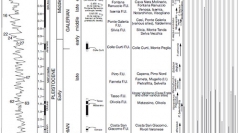

 Geodiversitas
33 (3) - Pages 485-517
Geodiversitas
33 (3) - Pages 485-517Paleoenvironmental variations that occurred in Italy from the Middle Pliocene to the Late Pleistocene are described. The number of large mammal species seems increased moderately, especially from the Galerian to the Late Aurelian biochronological units. On the contrary, the paleobotanical data show a decrease of the forest cover from the Middle Pliocene to the late Early Pleistocene and an increase of lands occupied by prairies and steppes. This change is also supported by the appearance of hypsodont taxa among mammals. The distribution of mammal faunas between the Adriatic and Tyrrhenian sides of Central Italy, during the Middle and Late Pleistocene, seems not to be influenced by climatic and environment differences. When the Adriatic data are more complete, it is possible, in fact, to observe a trend that is fairly close to that of the Tyrrhenian. The majority of megaherbivorous taxa has an Asian origin, and it can be hypothesized that in the interglacial phases, the Tosco-Emilian Apennines allowed the taxa coming from the northeast to enter and spread out into the more diversified Tyrrhenian side, whereas during the glacial periods the narrow Ligurian corridor were followed. This research supports the role of the Italian Peninsula as a refuge area for continental Europe; this particular condition permits the Italian mammal faunas to develop endemic lineage (such as Elephas antiquus italicus Osborn, 1931, Cervus elaphus rianensis Leonardi & Petronio, 1974, C. e. aretinus Azzaroli, 1947, etc.). At last, biodiversity sharply dropped during the last 30 000 years, probably due to the anthropic activities and the strong climatic cooling of the last pleniglacial.
Biochronology, Italy, Pliocene, Pleistocene, large mammals